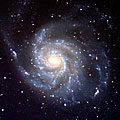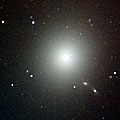Hubble Goes Deep
About Ultra Deep Field
As residents of the Milky Way galaxy, we live in a huge spiral system of about 1011 stars, much like the one shown in the photo. Spirals are common in the universe, as are ellipticals, which have no visible structure and typically are shaped like an egg or a football, as shown in the second photo. These two types make up about 97% of the galaxies in the universe.
Where did these galaxies come from? As recently as 2002, most astronomers believed that large galaxies were built up from collisions of small galaxies and did not appear until the universe was four or five billion years old.
To test theories of galaxy formation, astronomers must look further and further back in time. Seeing back in time is equivalent to seeing at a great distance, because the velocity of light is finite. If an observed galaxy is seven billion light-years away, the light that formed the image left the galaxy seven billion years ago, when the universe was about half as old as it is now. Ideally, a set of observations of galaxies at various times in the distant past would show if the predictions of a theory of galactic evolution were correct.
To determine the distance to a galaxy, astronomers measure the redshift of its spectral lines. Since the galaxies are receding, their spectral lines are Doppler shifted towards longer wavelengths, i.e. towards the red or, for very distant galaxies, beyond the red to the infrared. The redshift yields the recessional velocity, and then, with Hubble’s Law, determines the distance. Hubble’s Law states that for all distant galaxies, recessional velocity is proportional to distance and specifies the constant of proportionality.
The history of galaxy formation also has important implications for cosmology (see Catch a Cosmic Microwave). Right after the Big Bang, the universe was a stew of nuclear particles, free electrons, and intense radiation that scattered from the electrons. Once the universe had expanded and cooled sufficiently, stable atoms formed and the radiation went its own way, no longer interacting significantly with matter, leading to the so-called “Dark Ages."
Only through star formation, initiated by gravitational collapse of hydrogen gas clouds, could the universe relight. Hot young stars gave off copious amounts of visible and ultraviolet, which reionized the intergalactic hydrogen and ushered in the “reionization era,” expected to last from about 500 million years to about a billion years after the Big Bang.
In the search for distant galaxies, a number of studies with the Very Large Telescope, Gemini Telescope, Spitzer Space Telescope, and Hubble Space Telescope found large galaxies where they were not expected—at a distance that corresponded to three to six billion years after the Big Bang, not at all what the hierarchical model had predicted.
To go back even further in time, astronomers must overcome the problems created by the shifting blanket of Earth’s atmosphere, which in fact is the source of the familiar twinkling of bright stars. As starlight passes through a column of air to reach the telescope, changes in density along this column—due to winds, convection, and the mixing of regions of different temperature—move the telescope in and out of focus constantly. The Hubble Space Telescope (see photo) avoids these problems by capturing images from Earth orbit, well above the atmosphere, a triumph of remote sensing and robotics.
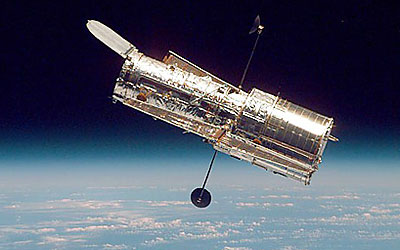
The Hubble Space Telescope (photo courtesy of NASA/STScI)
Research
In 2004, the Hubble looked deeper than ever into space, trained on a narrow patch of sky below Orion where Earth-bound telescopes hadn’t seen much of anything. Since the Hubble can observe only when facing away from the sun, Earth, and moon, observations required over 800 separate exposures on 400 orbits, spread over almost four months. During each exposure, light from the faintest objects dribbled in at the rate of only about one photon (light quantum) per minute—equivalent to observing a firefly at the distance of the moon—over the 280 hours of observing.
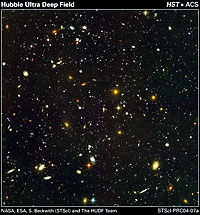
The Hubble Ultra Deep Field Image, showing 10,000 galaxies within a slice of sky about a tenth as big as the full Moon. (Image courtesy of NASA, ESA, Steven Beckwith and the HUDF Team at the Space Telescope Science Institute).
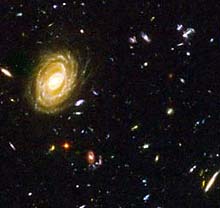
A closeup from the Hubble Ultra Deep Field. A graceful spiral galaxy is seen as it was about a billion years after the Big Bang, much earlier than such galaxies were to have formed according to the hierarchical model. Note that this galaxy shares the same field with faint red galaxies that are much older. (Image courtesy of NASA, ESA, Steven Beckwith and the HUDF Team at the Space Telescope Science Institute)
As successive exposures were added to the image, progressively fainter galaxies emerged. The resulting Ultra Deep Field revealed a profusion of 10,000 galaxies, including many with unusual shapes and some that appear to be interacting. (see image).
Note that within the Ultra Deep Field (see second image), the familiar-looking spiral and elliptical galaxies share the field with many faint red shapes, which are far more distant. These faint red objects have been identified as the youngest galaxies ever seen, some so far back in time that they emitted their light within 400 million years of the Big Bang, about 95% of the way back to the beginning of the universe.
The Ultra Deep Field contains a preponderance of small galaxies, most with masses far smaller than our own Milky Way galaxy. These smaller proto-galaxies do fit the hierarchical theory’s prediction that small galaxies combined to give the large galaxies we see in the modern universe.
Many of the most distant galaxies have strange shapes—some like toothpicks, and others bracelet links—these are collective known as “train wrecks.” Some of the most distant galaxies seem to be interacting.
As for observing the “reionization era,” Hubble astronomers think they have seen its trailing edge, but others do not agree. In any case, future observation programs call for looking at many parts of the sky and pushing even further back in time.
To follow up on the Ultra Deep Field results, the Keck observatory, located on a Hawaiian mountaintop (see photo), will train its 10-meter mirror on the same patch of sky to study the infrared spectra of these faint, newly-observed galaxies. Using a technique called “adaptive optics,” the collected light is reflected from a deformable mirror, whose shape changes hundreds of times a second to compensate for the changes in the atmosphere.
According to a report on the Hubble Space Telescope News Center , the Ultra Deep Field will remain the definitive view of the most distant galaxies until the James Webb Space Telescope is launched by NASA in 2011. That instrument will have a mirror about 2.6 times larger than the Hubble’s, and collect about seven times more light.
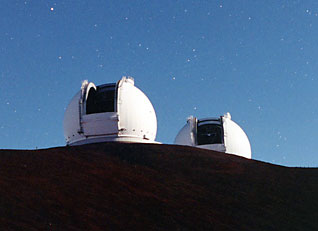
The twin Keck telescopes, one optical and one infrared, on the Mauna Kea volcano in Hawaii (photo courtesy W. M. Keck Observatory)
Links
Space Telescope Science Institute
NASA
Gemini Observatory
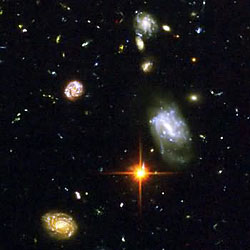
Another closeup from the Hubble Ultra Deep Field (Image courtesy of NASA, ESA, Steven Beckwith and the HUDF Team at the Space Telescope Science Institute)










